Menu
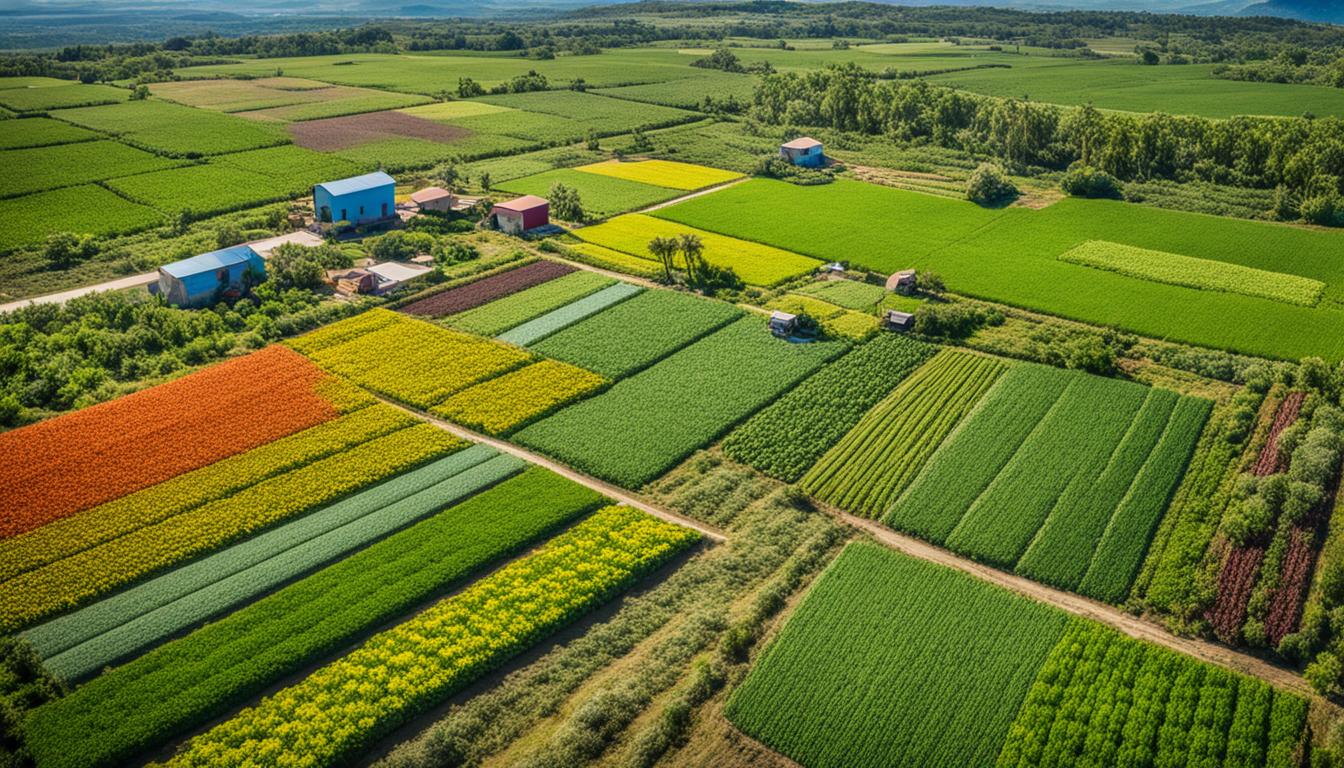
Before 1959, over 70% of sugar production in Cuba was controlled by US companies. They also held significant parts of the telephone, electric, and public railway services. Yet, since 1989, Cuba has moved towards sustainable and regenerative farming.
When the Soviet Union stopped supporting Cuba and the US started an embargo, change was forced. This led to a huge shift towards sustainable farming in what is now called the “agroecological revolution”. Small farms especially benefitted.
The Campesino-to-Campesino Agroecology Movement (MACAC) and the Cuban Association of Small Farmers (ANAP) played vital roles. They taught farmer-to-farmer, sharing important skills. By using more ecological methods, Cuban farmers could grow more. They did this while spending less on imports, even during tough times.
Cuban agriculture has changed a lot. It used to focus on just one type of crop and used many chemicals. But, in the early 1990s, it turned towards eco-friendly practices. This change came due to a big problem. This problem led them to try out agroecology.
Before the revolution, US companies had a big part in Cuba’s sugar production. This made Cuba depend a lot on others. After 1959, Cuba made changes. It took control over its farming industry. It also made sure that people in the countryside could read by 1961. These changes helped the economy of rural areas.
Agroecology in Cuba is all about being sustainable, strong, and smart with money. It mixes organic farming with agroecology. This mix helps to cut down costs. By 2018, 200,000 families were part of the Farmer-to-Farmer Agroecology Movement. This large number shows that the project is doing well.
Today, agroecological methods are a big part of farming in Cuba. Many small farms use these ways. This shows a big change in how farms work. Agroecology has boosted how much food farms can produce. It has also helped keep the land and money in good shape. In 2009, there were 110,000 families part of this movement. By now, this number has doubled.
The Cuban agroecological movement started with the Cuban Association of Small Farmers (ANAP) and the Campesino-to-Campesino Movement (MACAC). These groups changed the way farming was done across Cuba. By 2018, the country had over 200,000 agroecological farmers. This was a big leap from just 200 in 1999. It shows how powerful agroecology can be in changing farming for the better.
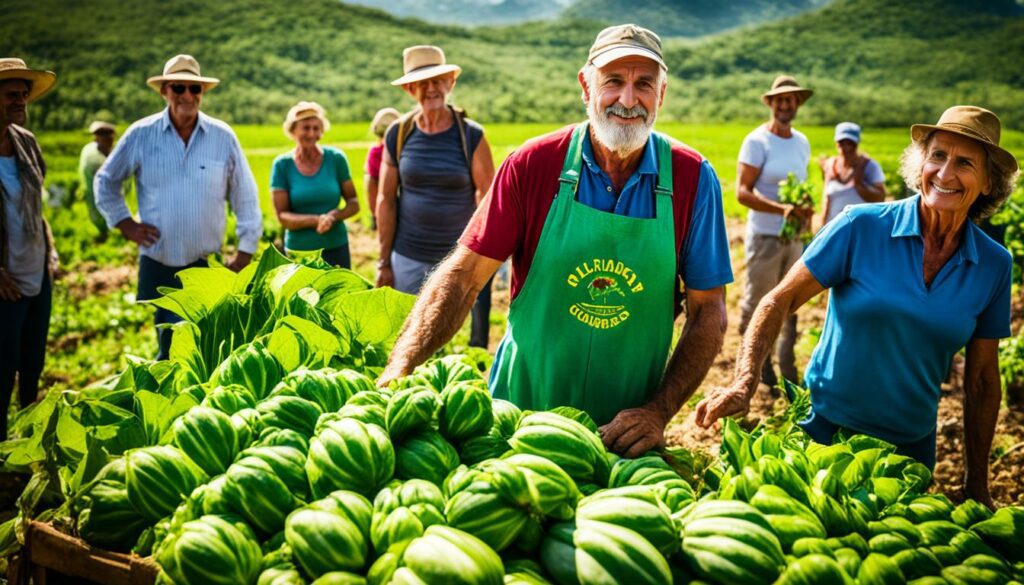
ANAP is key to getting small farmers to use agroecological methods. They run programmes to teach farmers these new ways. The aim is to use fewer imported chemicals and make farms more eco-friendly.
ANAP has found ways to increase farm production and lower costs with their methods. Farming this way boosts food security and helps small farmers earn more money.
MACAC is also important in this change. Part of a global network called La Via Campesina, they focus on farmers sharing knowledge. Lessons include how to make seeds more suited to Cuba’s land and weather. The idea is to grow better crops despite climate change.
MACAC is working to connect these farmers to sell more organic food. They are trying to make the market want more farm-fresh, natural food.
But, the Cuban government still mostly supports traditional farming with lots of chemicals. ANAP and MACAC are pushing for a greener, more sustainable future. Their work is slowly changing Cuban farming for the better.
In 1989, Cuba began a big change in farming. They moved away from just growing one crop. This change was needed because the soil was getting worse and crops were not doing well, especially rice, in the 1980s.
Key to this change were the farmers. They got help from the Cuban Association of Small Farmers and the Ministry of Higher Education. They started using different farming techniques like rotating crops and mixing animals with plants. Agroforestry was also introduced.
This new way of farming made the soil better and increased crop production. It was cheaper too. The Cuban farmers shared their new knowledge without waiting for the government. This helped spread the change quickly.
Yet, the shift was hard for the farmers in the beginning. The first five years were tough and they had to give up a lot. But, the support from the government and others helped. They began using less chemicals and more natural ways of farming. This made their farms stronger and more sustainable.
Sustainable agriculture in Cuba is making a big difference. This is visible in its environmental, economic, and social aspects. Cuba’s focus on farming that cares for the earth has brought many benefits. These include helping the environment and boosting other areas too.
Cuba is seeing positive changes in its environment thanks to sustainable agriculture. The move from old ways – which used lots of harmful chemicals – to greener methods is working. For example, when the country had less access to these chemicals, they started using better, more sustainable options. This change has helped keep the soil healthy and made agriculture more ready for climate challenges.
The shift to sustainable farming has not only helped the environment but also Cuba’s economy. It used to import 57 percent of its food, which was costly. Now, efficient farming on smaller lands benefits more locals. These farms show how much better it is to farm in eco-friendly ways. They help communities grow stronger and keep money within the country by reducing what they spend on imports.
The move to sustainable farming in Cuba is bringing people together and providing more work options. Women, young people, and the elderly are getting involved. This has improved life in rural areas. It’s also making the food system there more secure, which is important for everyone’s well-being. Almost 11 percent of the area’s scientists joining in these efforts is a sign of Cuba’s real commitment.
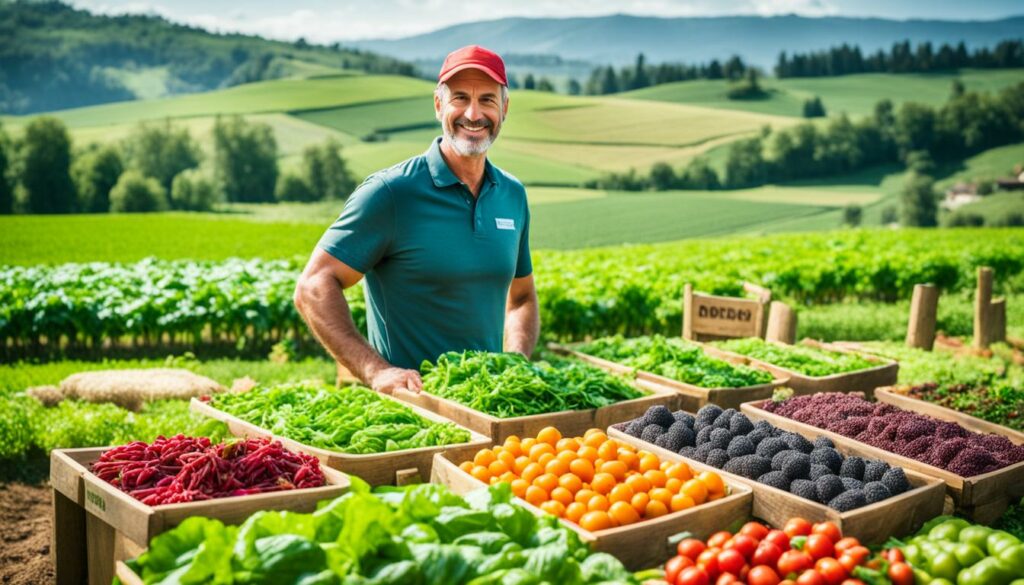
Since 1989, Cuba has been using agroecological farming methods. These methods have totally changed how farming works there. The change really took off in the 1990s. It was helped a lot by a farmer-led movement called MACAC.
This movement helped farmers switch from using lots of chemicals to more natural ways. They started using things like biofertilisers and biopesticides. By doing this, Cuba’s farmers saw their soil become healthier. They also needed to use fewer chemicals from other countries.
Using crop rotation and mixing crops with livestock made farming even better in Cuba. Farming that includes trees, called agroforestry, also took off. This helped the soil stay healthy and balanced the local environment. Now, farms are not just more productive but also ready to face changes in the climate.
A special project called the Agroecological Lighthouses Programme started in the early 1990s. It showed farmers how well agroecology could work. Almost half of Cuba’s small farm families have followed suit. By 2018, many farms in Cuba had tried these eco-friendly methods. Over a third used soil conservation, and almost all did some kind of eco-friendly pest control.
ANAP, a group for small farmers in Cuba, helped teach these new farming ways. They worked with others like the government, research groups, and NGOs. Together, they made farming in Cuba a lot more productive. From 1988 to 2009, small farmers saw almost a 200% rise in how much they could grow on their land.
More types of farming have meant more people can work in the countryside. This includes women, young people, and the elderly. It’s made farming villages stronger. But, Cuba still has to import a lot of its food. It shows they’re not completely self-sufficient yet. They’re working towards that goal with their eco-friendly farming.
Cuban agriculture changed in the 1990s from using lots of outside products to sustainable ways. By increasing the use of biofertilisers and biopesticides, they fought against a drop in crop yields. These changes helped with soil health and decreased the need for imported chemicals due to an economic embargo.

To see how using biofertilisers and biopesticides measure up against regular methods, the Agroecological Lighthouses Programme is a good example. It teaches others that these natural farming methods can work well. Now, 40 percent of food in Cuba is grown on small farms using only 20 percent of the land. This shows how important biofertilisers have become in Cuba.
The Cuban Association of Small Farmers (ANAP) has been key in this change. They’ve helped farmers share what they know. This sharing and working together have made it easier for farmers to use sustainable methods. This has helped increase how much food is grown and kept people fed.
At first, making these changes was hard. Scientists and farmers working together was a big part of solving these problems. Making laws and supporting research for these new farming ways also helped make biofertilisers and biopesticides more important in Cuba’s farming.
Helping new businesses in farming that want to use these natural ways is very important. This shows that changing from regular farming to using bio ways is a good step for Cuba. It helps the country grow its own food more and become more self-reliant.
Since the early 1990s, Cuba’s been leading in sustainable farming with the Lighthouses Programme. It sprang up after the USSR’s fall and grew stronger due to the US embargo. The Programme focused on sharing farming knowledge and help from the university ministry.
The programme’s core are the ‘lighthouses farms.’ These show the best ways to farm sustainably. Starting with using natural fertilisers and pesticides instead of chemicals, they proved that change was possible. Farmers in different areas shared what worked, making everyone learn faster together.
Local areas greatly benefit from the Programme. It’s helped farmers and students get better results with less money than the old ways. Besides teaching locally, these farms have helped start a Sustainable Development Master’s at the University of Havana. This bridges the gap between theory and real farming needs.
The Programme hit some bumps in its first five years but came out stronger. Thanks to ongoing support, it’s more than a quick solution. Its success is felt beyond Cuba, inspiring others in Latin America. It proves agroecology can truly change for the better, even when times are tough.
The move towards agroecology in Cuba has been very important. Crop diversification in Cuba lies at the heart of this change. It does a lot for the soil and offers big ecological and economic upsides. By mixing up their crops and changing them regularly, farmers deal better with pests and use nutrients smarter. This makes their farming stronger and more able to bounce back from tough times.

Cuba used to rely heavily on outside help and grew just one crop in large fields from the 1960s to early 1990s. But, it all started to change in 1989 as they looked for alternatives to the damage done by just growing one thing and using lots of chemicals. The start of the Agroecological Lighthouses Programme in the 1990s was key. It proved that spreading out the types of crops grown works well, and this idea spread quickly across Cuba.
Rotating crops in Cuba is more than just good for the soil. It makes dealing with pests and diseases easier, which means less need for harmful pesticides. Thanks to this, Cuban farmers have cut down on pesticide use by as much as 85%. The results are clear. There’s more food, with an increase of 85% in tuber production, 83% more veggies, and a huge 351% rise in beans.
Now, looking at how farming sustainability strategies have been put into practice, we see the Cuban Association of Small Farmers (ANAP) play a key role. This group of small farmers is very active and has really helped others pick up the benefits of growing a variety of crops. Grassroots work like this, along with government support for agroecology, has made a big difference.
What Cuba teaches us is that working together can make real change happen. Scientists and farmers team up to tackle organic farming issues. This ongoing teamwork keeps improving how crop diversity and rotation are done, turning Cuba into a shining example of sustainable agriculture. Their success shows that farming in a way that’s good for the environment can also be very good for keeping farms going strong for years to come.
Agroforestry and crop-livestock systems are big parts of Cuba’s farming. They blend trees, crops, and animals together. This mix boosts nature’s variety and helps farmers make more money. It works well for the earth, profits, and people.
In Cuba, they plant different trees along with crops to make the land more fertile. Also, they combine animals, like pigs, with growing fruit. This sharing helps the land stay healthy without using lots of chemicals. It also keeps pests away naturally.
Looking at examples in Cuba shows how well this method works. We saw 17 farms in places like Guadeloupe, the Brazilian Amazon, and Cuba. They found combining crops with animals makes the farm do better. Up to 2018, about 200,000 families were doing this. It helped them grow more food and be stronger against hard times.
Studies found that what you have and how hard you work matter a lot. For instance, managing nitrogen well boosts how much you can grow. This lesson helps farmers a lot.
To wrap up, what Cuba is doing with farming is really showing results. They’re putting trees, crops, and animals together in smart ways. This makes their farms and lives better, which is great news for all of us.
In Cuba, the Farmer-to-Farmer knowledge exchange shows how shared learning can make a big impact. It uses local farmers called Rocales to spread their wisdom. This method helps farmers learn from each other, becoming better at what they do. They share tips and new ways of farming that they’ve tried themselves.
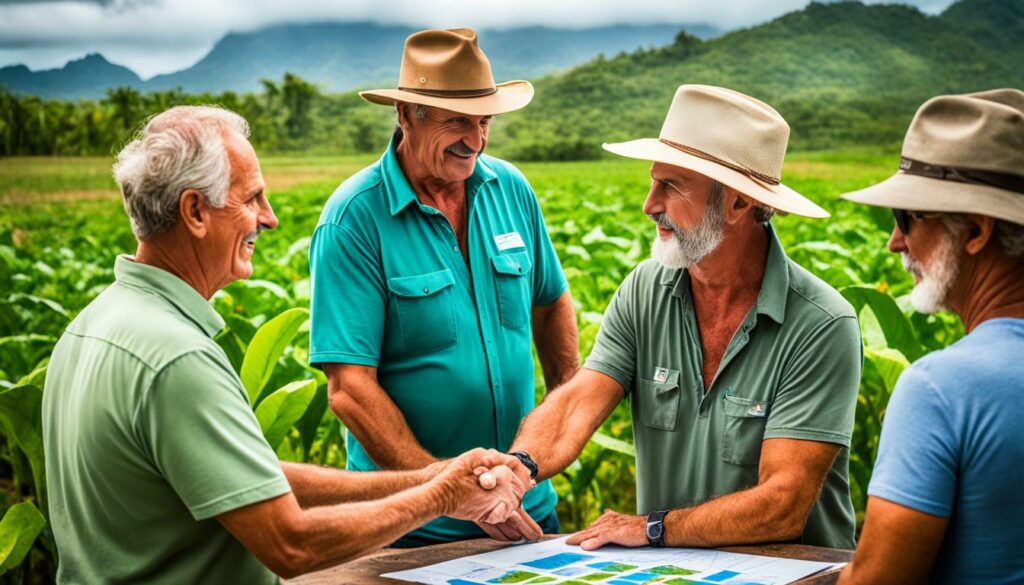
In the Cuban countryside, promoter farmers are key players in the agroecology scene. By 2018, half of Cuba’s farming families joined in, thanks to them. They have a big part in making sure farmers help each other learn and stand together. These special farmers teach their peers things like how to care for the soil and manage pests naturally.
Learning on farms in Cuba is a team effort, led by experienced farmers. With their guidance, over 91% of farms there now handle pests the natural way. This style of learning helps spread good farming practices widely. Thanks to this, farming improved so much that by 2009, more was grown than the country planned for. Many families even grew enough food in 2011 to eat and sell more.
| Year | Promoter Farmers | Campesino Participation |
|---|---|---|
| 1999 | 200 | NA |
| 2009 | 110,000 | 50% |
| 2018 | 200,000 | 50% |
The National Association of Small Farmers of Cuba (ANAP) has greatly boosted training and support. Now, more than 3000 groups and co-ops are involved, with around 180,000 farmers. The effort put in by promoter farmers shows how well this way of learning works. Together, they have created a very strong farming community that looks after the land well.
Agroecology has greatly boosted Cuban food security by making the country more self-sufficient. This has helped farmers be more resilient against tough weather. The MACAC, a farmer-led movement, has grown quickly. It now has 200,000 families, nearly double since 2009.
Many farms in Cuba use agroecological methods. These have led to a big increase in productivity for small farmers. By 2011, many farmers were producing enough for their families and even more to sell.
Agroecology isn’t just good for the land; it’s boosting income for farms, too. It’s creating new job opportunities for all, from the young to the old. It’s also helping farms be better prepared for climate changes like hurricanes. Plus, it’s lowering their impact on the environment.
Cuba is changing the way it farms, moving towards more sustainable ways. This shift is clear from several key points:
| Aspect | Traditional Practices | Agroecological Practices |
|---|---|---|
| Membership of MACAC (2009-2018) | 110,000 families | 200,000 families |
| Soil Conservation Techniques | Less Usage | 38% of farms |
| Agroecological Pest Management | Minimal Usage | 91% of farms |
| Farm Productivity (1988-2009) | Baseline | +200% |
| Food Self-Sufficiency (2011) | Varied | 70–100% |
| Income Levels | Standard | Increased |
| Fuel and Carbon Emissions | Higher | Reduced |
Agroecology is key to Cuba’s food security. Its move to more sustainable farming is building a stronger future. It’s not just changing Cuba; it’s showing the world how agroecology can help with food security.
The move to agroecology in Cuba is a great step, but not without hurdles. Small-scale farmers face hefty initial costs. These costs make it tough for them to switch their farming methods at first. It takes about five years for them to start seeing positive returns.
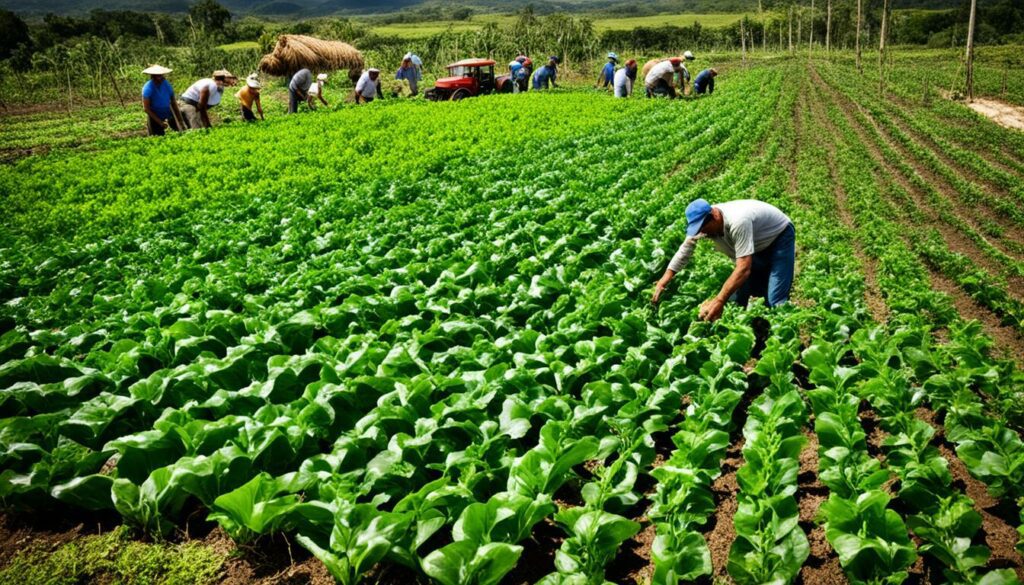
The switch to agroecology starts with a big hit to the wallet. Farmers must buy new seeds and eco-friendly pest control. At the same time, they must look after their basic needs. This financial pressure can put farmers in a tight spot. They need new and creative ways to handle their money. They also need help from government and non-government sources.
| Strategy | Description |
|---|---|
| Farmer-Scientist Joint Ventures | Collaborative ventures to develop and implement agroecological methods, distributing both risks and benefits. |
| Local Seed Companies | Initiatives aimed at creating farmer-managed seed companies to ensure a steady supply of high-quality, agroecological seeds. |
| Access to Credits | Provision of financial support to green entrepreneurs, allowing them to overtake initial economic barriers swiftly. |
There’s a constant need for better ways to farm sustainably. More research is needed to improve agroecological farming methods in Cuba. ANAP and similar groups are key in this effort. They bring farmers and scientists together to make progress in farming. This team effort is vital for finding new ways to farm, cutting costs, and increasing production.
One of the amazing success stories comes from Cuban farmers. They have made a big change through the Campesino-to-Campesino Agroecology Movement (MACAC). This movement helped jump the number of agroecological farmers from 200 in 1999 to 200,000 by 2018. This means more than half of all the small farmers now practice agroecology.
Agroecological farming in Cuba is showing great promise. It not only boosts what farms produce but also makes sure people have enough food locally. This way of farming includes planting different crops together. This helps the soil stay healthy, lessens the need for harmful chemicals, and protects against the changing climate. MACAC also focuses on using things found locally. This makes farming sustainable without needing outside help.
The use of better seeds through sharing and mixing them has also played a big part. It helps crops grow strong even when the weather isn’t perfect. This part is very important because the world’s climate is changing. It’s making it hard for farmers everywhere.
Agroecology has cut down a lot on the need for chemicals that are brought in. This is a big deal for Cuban farmers. It makes farming more stable against sudden changes like with money or politics. This change has helped the economy of farming and the health of the environment. Farmers have joined hands to share what they know. This makes everyone smarter and better at coping with challenges.
The table below presents a comparative overview of traditional chemical-dependent monoculture systems versus agroecological practices:
| Aspect | Conventional Monoculture | Agroecology |
|---|---|---|
| Production Costs | Higher | Lower |
| Use of Chemicals | High dependency | Minimal |
| Resilience to Climate Change | Low | High |
| Food Security | Unstable | Enhanced |
| Local Resources | Limited | Maximised |
These examples show how Cuban farmers are leading in making agriculture sustainable. Their teamwork and smart choices have been a big success. This makes them a shining example for farming around the world.
I am currently studying Agroecology at UC Santa Cruz. This year, my journey takes me to Cuba for a practicum. I have 15 years of experience in farming, mainly in Vietnam. Now, I look forward to learning Cuban agricultural methods.
Thanks to a scholarship, I will spend 18 days in Cuba. My main aim is to learn about creating a just and eco-friendly food system. I’m keen to discover Cuban indigenous farming ways and to meet agricultural managers. This is part of my bigger dream to help improve farming in Vietnam.
Cuba has unique socio-economic challenges. But, these have led to an independent and sustainable agriculture model. By avoiding expensive chemicals and focusing on water and soil, Cuba thrives. It mostly grows its food, importing only basics like rice. Cubans have shown that this way of farming is better for the environment and more resilient.
About thirty years ago, Cuba started this sustainable model. It has since inspired others globally in fighting hunger and climate change. I aim to bring these lessons back to Vietnam. We can learn a lot about tropical farming from Cuba.
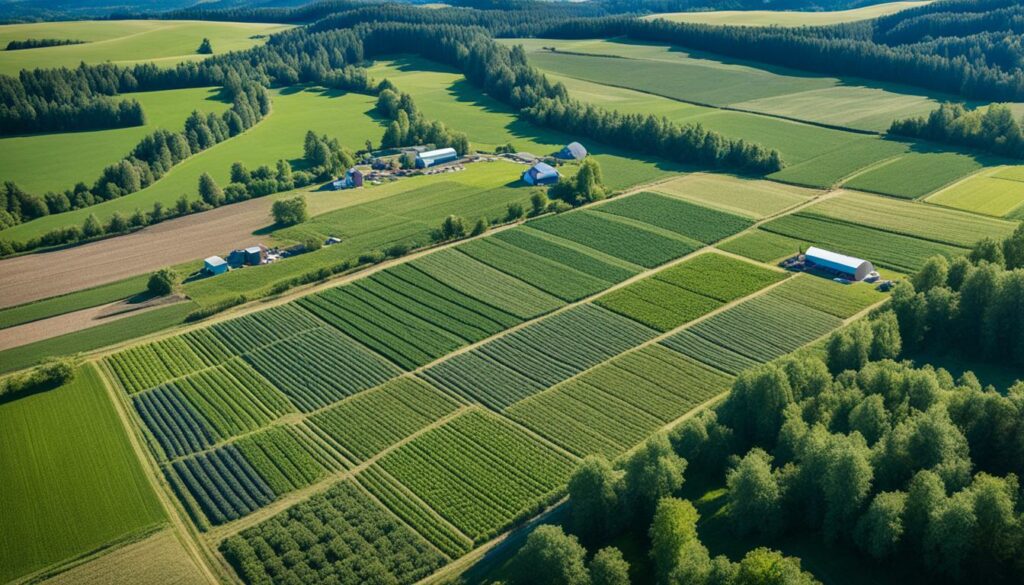
Cuba shows that agroecology fits local needs and is more sustainable than other methods. Also, Cuba highlights the importance of reducing meat consumption to protect the planet.
This trip to Cuba is life-changing. It’s about learning a sustainable farming model that works for the real world. What Cuba does shows us how to really protect our environment and feed our planet.
| Country | Agroecological Impact | Adoption Rate |
|---|---|---|
| Cuba | High resilience, local food security | 70% |
| Laos | Improved nutrition, reduced chemical use | 50% |
| Malawi | Climate adaptation, diversified crops | 60% |
| Vietnam | Potential for widespread adoption | 25% |
Cuba’s sustainable farming model gives hope for the future. It’s a practical and adaptable approach to farming. This Cuban model is a key example of how to protect our planet while feeding everyone.
The move to agroecology in Cuba shows how policies can help farming while being kind to the Earth. The government’s push has led to better crop yields and lower costs than old chemical methods. It’s a big change from the past ways of farming.
Since 1989, Cuba has been at the forefront in supporting nature-friendly farming. This came after hard times in the 1980s and a need for change. By the 1990s, the government started special farms to test these new methods. An organization called the Cuban Association of Small Farmers helped share ideas among farmers, leading to a strong farming movement across Cuba.
NGOs and groups from other countries also joined in to help Cuba’s new farming approach. They started breeding plants in a way that kept nature in mind. Local farmers began seed businesses and green start-ups got a hand through loans. Thanks to everyone’s efforts, over 200,000 families support the new farming way.
This teamwork has greatly boosted crop output since 1988. Small farmers now produce nearly twice as much. And, these eco-friendly methods have spread, touching the majority of farms in Cuba.
Women are playing a key part in Cuban farming. They’re doing a lot in the fields, from cutting cane to managing crops. Also, they advice on farming and run urban farms. Their efforts have boosted productivity and helped them be more financially independent.
Young people are also diving into farming. The Farmer-to-Farmer Movement (MACAC) has got almost 200,000 families involved by 2018. This means half of Cuba’s small farmers are now part of it. The movement has grown fast, starting with 110,000 families in 2009. Since the late 90s, a third of families have switched to agroecology, which has led to better crops and more money.
This new way of farming isn’t just better for the environment. It’s opened up more roles for everyone, including older folks. Now women often look after kitchen gardens and animals. They’re also helping with harvests. And the younger generation getting into farming means more farms are turning to eco-friendly methods. This is cutting down on using harmful chemicals.
Groups like the Federation of Cuban Women (FMC) are big supporters. They hold events and give out awards to show the important work done by women in farming. There are also programs and workshops for young people. These efforts help them learn and share farm work fairly within their families.
Agroecology is making farming in Cuba stronger and more equal. It’s creating new jobs and making farms more able to face bad weather. These changes are not just about farming better now. They’re helping build a farming future where women and young people are central.
| Statistics | Details |
|---|---|
| Families Engaged in MACAC | 200,000 by 2018 |
| Women in Decision-Making Roles | 18.5% |
| Increase in Farm Productivity | 200% between 1988-2009 |
| Percentage of Agroecological Pest Management | 91% |
When we think about the future of Cuban farming, we must focus on keeping things sustainable. Over the next ten years, Cuba will work hard to make its farming more earth-friendly and ready for tough times like climate change. Setting tough but reachable goals that match Cuba’s love for new farming ideas is key.
To hit the sustainability bullseye, Cuba has to do a lot of things at once. The country’s agroecology gurus are leading efforts to make sure food grows in ways that are fair and good for the earth. They started with eco-friendly fertilisers and bug killers to move away from harmful chemicals. Now, they aim to make soil better, have more plants and animals, and grow different kinds of food.
Being innovative is what makes Cuban farming move forward. New ways to farm mean they learn and achieve more. Projects, like the Agroecological Lighthouses and sharing tips among farmers, play a big role in this. Using trees on farms and smarter ways to mix animals and crops can make everything work better and last longer.
| Focus Area | Strategies | Expected Impact |
|---|---|---|
| Sustainability Goals |
|
|
| Future Innovations |
|
|
Looking at Cuba’s agroecological movement, it’s clear it sets an impressive example of sustainable farming. It started during tough times and has since deeply changed how farming works in Cuba.
Cooperatives, like CCSs and CPAs, now use a lot of land. By 1998, they managed over 1 million hectares. With UBPCs joining in, they covered 40% of Cuban farming land by 1997. This shows a big move to more different kinds of farming across the country.
Cuba’s story also shows how small, local projects can be very powerful. For example, the Farmer to Farmer Agroecological Movement helped a lot of families learn and become stronger over just ten years. And with over 40 agroecology schools, the country is committed to food independence and looking after the planet.
To sum up, Cuba’s way of farming is a great guide for the whole world. It proves that caring for the environment and our health go hand in hand. This approach teaches us a lot about working together for a farming future that’s good for everyone.
In Cuba, the agroecological revolution happened due to big problems in the 1990s. The Soviet Union ended its help, and the US put an embargo on trade. This made Cuba switch from using a lot of chemicals and planting just one crop to more earth-friendly farming.
The ANAP was key in spreading agroecological ideas. They taught farmers new methods through education. They also started the Campesino-to-Campesino Agroecology Movement (MACAC). This movement, led by farmers, changed how agriculture worked in Cuba.
Cuba uses a few main techniques for agroecology. They include growing different crops together, rotating crops, planting trees with crops (agroforestry), and controlling pests in natural ways.
In Cuba, biofertilisers and biopesticides are very important. They replace harmful chemicals. These natural substances help keep the soil healthy and protect the environment.
Agroecology has made Cuba more secure about its food. It’s helped the country grow its own food better. This means they rely less on imports, making their food supply more stable.
The change to agroecology in Cuba was not easy. It cost money and needed a lot of research. Scientists and farmers need to work together to keep making these methods better.
Many Cuban farmers have done well with agroecology. They now produce more, earn more money, and help the environment. Their stories show that this way of farming really works.
This programme is about farms that show how to farm using agroecology. These farms are like beacons, leading the way. They help others learn about successful agroecological practices.
Having different crops and changing where crops are planted helps keep the soil good. It also helps control pests. This makes farming last longer and be more stable.
Women and young people are very important in Cuban farming. They do many jobs that help farms be better. Their work helps make farming last and helps villages stay strong.
Agroforestry is a big part of farming in Cuba. It mixes trees with crops and animals. This helps nature and adds ways for farmers to earn money. It’s about farming in a way that keeps the land and environment healthy.
This knowledge sharing has made Cuban farming better. It’s farmers teaching farmers. They share ideas that help them all. This has helped the whole country get better at agroecology.
The government, along with groups inside and outside Cuba, has helped a lot. Their support has made agroecology stronger and able to grow. Policies have been made to keep agroecology going in a good direction.
Agroecology is the future for Cuba’s farming. They are working on ways to keep farming healthy for the land. This includes making less impact on the environment and being ready for a changing climate.
The Cuban way of farming has got the world’s attention. It shows that a whole country can farm in a way that’s good for the earth. It’s an example for other places to follow, promoting a greener and more sustainable future.